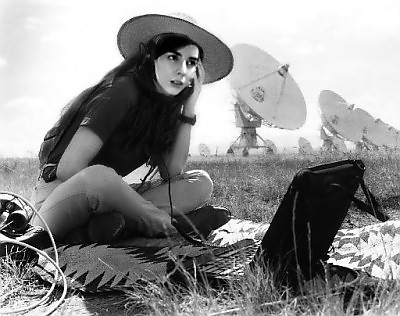An artist's depiction of the two Voyager spacecraft as they approach interstellar space. Image credit: NASA/JPL.
Hi Nathalie,
I do have a question about space-time. How is it that all the different stars can be connected to us…? They seem a lifetime away. Is there any relation between the history of space, and a spiderweb — like if you touch a spiderweb with a finger, it moves and affects the whole web…
From,
Whoa, It’s Like… Duuuuude
————————————————
Dear Dude,
Okaaaay, err… Let me try and break this question into manageable parts I can actually answer. Alright, stars being connected to us. So I could argue that all these stars have a gravitational effect on us, since they are so massive, but gravity is a force that falls with radius squared. That means that, while we are basically controlled by the Sun’s gravitational field, the next closest star (Proxima Centauri) which is 4.24 lightyears away doesn’t have a whole lot of effect on us. Furthermore, lines of a gravitational field cannot “move” faster than the speed of light. That means that if Proxima Centauri were to suddenly vanish without a trace, whatever tiny amount of gravitational effect it has on Earth would not disappear until 4.24 years after the star’s disappearance. On a shorter distance scale, that means that we would not notice the Sun’s sudden disappearance until 8 minutes after the fact, since the Sun is about 8 lightminutes away from Earth.
The Universe is heavily interconnected. The Sun moves around the Milky Way based on the gravitational field created by the sum of all the other stars in the Galaxy. Our Milky Way moves around the Universe based on the gravitational field created by the sum of all the other galaxies in our Local Group of galaxies. Our Local Group as a whole is moving away from other clusters of galaxies based on the expansion of the Universe. These phenomena require the compounded effects of millions and billions of objects, though. Unless they’re very close to each other (like within a stellar system), single objects don’t really affect other objects.
As an example, the Voyager I probe which was launched in 1977 is on the cusp of exiting the Sun’s sphere of influence and entering interstellar space. Once it does, the magnetic and gravitational fields of the Sun will have a much weaker effect on the probe. It has travelled nearly 0.002 lightyears to get to this stage. Compare this distance to the diameter of our Galaxy, 120 000 lightyears, and we realize the Sun’s influence is short ranging. Add the Sun to all its stellar neighbours, though, and you create massive fields!
I feel there might be a really cute moral to this story along the lines of “If you work together, you can fling neutron stars out of the galaxy!”.
Enjoy!
Nathalie

